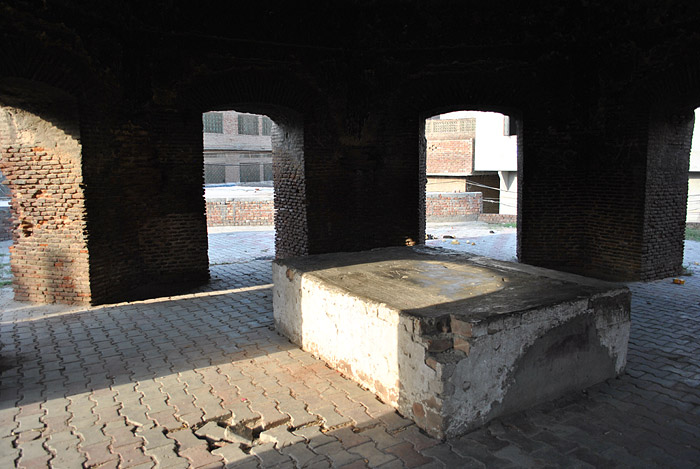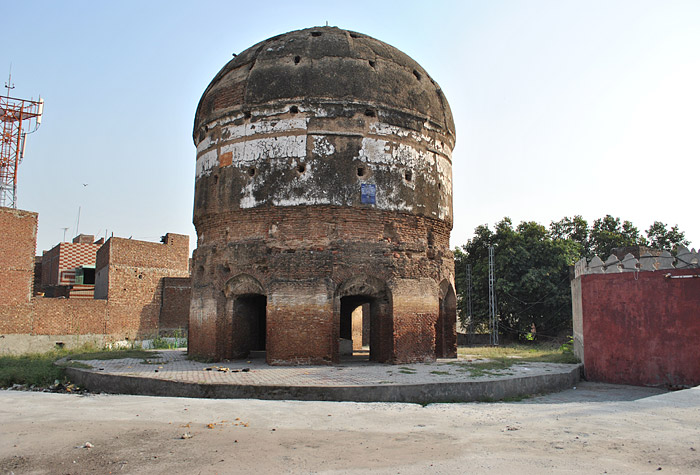Prince Pervez Tomb

Tradicionalmente, esta tumba se atribuye al príncipe Pervez, uno de los hijos del emperador Jahangir. El historiador Latif, que documentó activamente sitios arquitectónicos en Lahore a fines del siglo XIX, tiene una opinión diferente y escribe:
'En la época de Shah Jahan, floreció un mercado en este lugar, que se llamaba Parewzabad. Los antiguos habitantes todavía conocen el lugar como Perwezabad.
La cúpula se conoce como la Maqbara del Príncipe Parwez, segundo hijo de Jahangir, y tanto Chishti como Mufti Ghulam Sarwar la atribuyen a ese príncipe. Pero Parwez murió de delirium tremens en 1036 A.H. (1626 DC) en Burhanpur (Deccan). El Emperador escuchó esta noticia en Cabul [Kabul], sobre su liberación del cautiverio a través de los esfuerzos incansables de su fiel esposa Nur Jahan, y Shah Jahan se convirtió en el heredero más probable de la Corona.
Creo que es probable, a juzgar por el hecho de que el lugar todavía se llama Parwezabad, que este sea el lugar de entierro de los dos hijos de Parwez que, según se nos informa, fueron asesinados en Lahore junto con los otros Príncipes de sangre real, por orden de Shah Jahan, en su ascenso al trono, "sus cuerpos fueron enterrados en un jardín en Lahore".
En cualquier caso, la tumba se encuentra en un lamentable estado de conservación. Esto es tanto más desafortunado cuanto que su plan octogonal sugiere que un noble de alto rango o miembro de la familia real fue enterrado aquí. Originalmente, la tumba probablemente se encontraba en el centro de un gran jardín con puertas en cuatro lados (similar al diseño de la tumba de la tumba de Asaf Khan y el conjunto de paisajes). No sobreviven rastros de las puertas o jardines y las viviendas modernas han invadido casi hasta el borde de la tumba. La parte restante de la tumba se encuentra desprovista de gran parte de la decoración de su superficie, que probablemente incluía revestimientos de mármol y bajorrelieves. El sarcófago de mármol que alguna vez albergó fue retirado en el siglo XIX o antes y reemplazado por una réplica de ladrillo tosco.
Traditionally, this tomb is attributed to Prince Pervez, one of the sons of Emperor Jahangir. The historian Latif, who actively documented architectural sites in Lahore in the late 1800s, holds a different view, writing:
'In the time of Shah Jahan, a market flourished at this place, which was called Parewzabad. The spot is still known by the old inhabitants as Perwezabad.
The dome is known as the Maqbara of Prince Parwez, second son of Jahangir, and both Chishti and Mufti Ghulam Sarwar ascribe it to that prince. But Parwez died of delirium tremens in 1036 A.H. (1626 AD) in Burhanpur (Deccan). The Emperor heard this news at Cabul [Kabul], on his deliverance from captivity through the unwearied exertions of his faithful wife Nur Jahan, and Shah Jahan became the most probable heir to the Crown.
I think it probable, judging from the fact that the place is still called Parwezabad, that this is the burial-place of Parwez's two sons who, we are informed, were murdered at Lahore along with the other Princes of royal blood, by order of Shah Jahan, on his ascession to the throne, 'their bodies being buried in a garden at Lahore'.
In any case, the tomb is in a deplorable state of conservation. This is all the more unfortunate as its octagonal plan suggests that a high-ranking nobleman or member of the royal family was buried here. Originally, the tomb likely stood at the center of a large garden with gateways on four sides (similar to the layout of Asaf Khan's tomb tomb and landscape ensemble). No traces of the gates or gardens survive and modern housing has encroached nearly to the edge of the tomb itself. The remaining portion of the tomb stands denuded of much of its surface decoration which likely included marble cladding and bas reliefs. The marble sarcophagus it once housed was removed in the 19th century or earlier and replaced with a crude brick replica.

